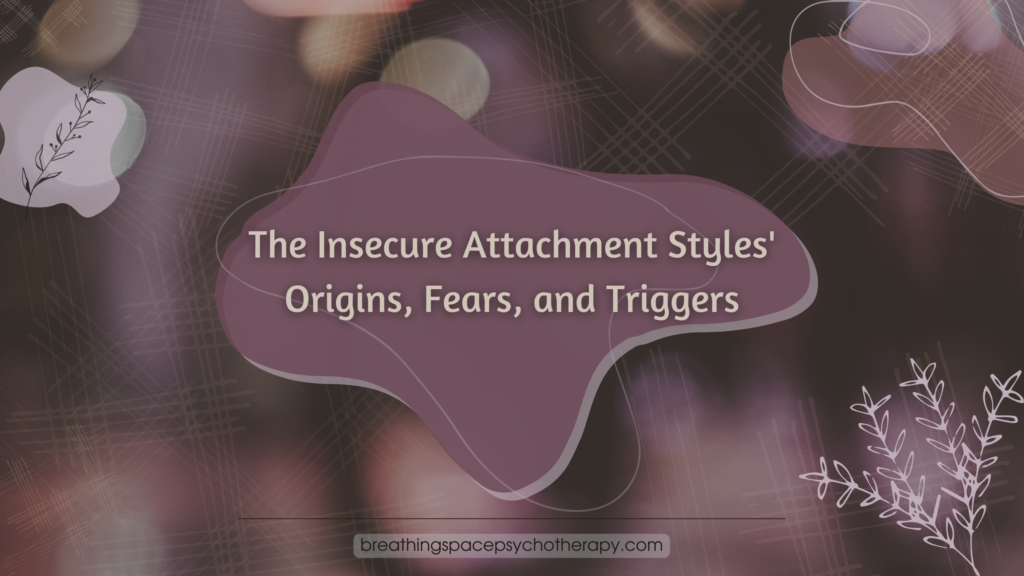What are attachment styles?
Attachment style refers to the way we interact with and relate to people in close, intimate relationships. They influence our beliefs, behaviors, and the way we process intimacy and emotions.
Our attachment styles are established early in our life and remain stable over time. Our attachment style can be changed anytime during childhood and adulthood due to intervening experiences, such as healing, self-work, and traumas.
Secure Attachment
A secure attachment style develops from safety, stability, and satisfied needs. If our attachment figures meet our needs and make us feel safe, understood, and important, then we are more likely to develop a secure attachment. There is only 1 recognized secure attachment.
Insecure Attachments
On the other hand, insecure attachment styles—there are three recognized insecure attachment styles—develop from confusing and inconsistent emotional communication and unsatisfied needs. If our attachment figures make us feel unsafe, unheard, and unimportant, and they inconsistently, inaccurately, or never meet our needs, then we are more likely to develop 1 of the 3 insecure attachments.
Note about Attachment Styles
It is important to note that the attachment figure may not intentionally neglect a child/individual. Attachment styles are formed from the perception that our needs are or are not met.
Here are the 4 recognized attachment styles.
- Secure attachment (SA): These individuals are emotionally mature, resilient, and have a positive self-image.
- Anxious attachment (AA or AP): also referred to as anxious-preoccupied, ambivalent, or ambivalent-anxious attachment. These individuals struggle with low self-esteem and feelings of unworthiness and tend to cling to their attachment figures.
- Dismissive-avoidant attachment (DA): These individuals avoid intimacy by withdrawing and distancing themselves.
- Fearful-avoidant attachment (FA): also referred to as disorganized, disoriented, or anxious-avoidant attachment. These individuals perceive their attachment figures as a source of comfort and fear.
Note: Insecure attachment styles are not mental disorders. Having an insecure attachment style is common; however, it can cause distress or harm relationships.
| What is your attachment style? Take one of these quizzes to find out! Both are free and only take five minutes to complete. Attachment Style Quiz (28 questions): This quiz requires an email to view your result and displays your percentage for each attachment style. Attachment Style Quiz: A 5-Minute Test To Find Out What Yours Is (31 questions): This quiz does not require an email and displays a single result and description of your attachment style. |
Anxious Attachment (AP)
An anxious attachment style is often developed in childhood when a child experiences misattuned or inconsistent parenting, or the child perceives their caregiver’s actions as unpredictable.
Contributing factors include:
- Caregiver is overprotective or intrusive;
- Inconsistent parenting behavior, i.e. sometimes the caregiver is nurturing and attuned to the child’s needs, but other times the caregiver is misattuned, insensitive, emotionally unavailable, or antipathetic;
- One caregiver is nurturing and attuned, but another caregiver is insensitive or emotionally unavailable;
- Emotionally abusive behavior;
- Caregiver experiences emotional hunger, i.e. the caregiver seeks out the child to satisfy their own needs rather than the child’s;
- Early separation from caregiver;
- Physical or psychological abuse.
As a result of their caregiver’s inconsistent responses, the child becomes confused, anxious, and uncertain if their needs will be met. They don’t know what behavior to expect from their caregiver. Eventually, the child distrusts their caregiver to meet their needs but still desperately wants connection.
APs hold three core maladaptive beliefs (as outlined by My AttachEd):
- Abandonment: Everyone I know and care about will eventually leave me.
- Subjugation: My needs are not important and don’t matter as much as others’ needs.
- Dependence: I can’t function on my own, and I need someone to make me feel safe and meet my needs.
Core Wounds
Here are 5 sets of major core wounds and their accompanying emotions as outlined by the Personal Development School:
- “I will be abandoned and that makes me unsafe.”
Accompanied by feelings of desperation, panic, distress, numbness, emptiness, sadness, and fear.
- “I am not good enough. I am rejected.”
Accompanied by feelings of sadness, despair, and fear of loss.
- “I am alone and unsafe.”
Accompanied by feelings of heaviness, loneliness, and hopelessness.
- “I am disliked, excluded, or don’t belong.”
Accompanied by feelings of hurt, jealousy, sadness, and fear.
- “I don’t matter. I’m not important. I am unseen. I am unheard.”
Accompanied by feelings of smallness and sadness.
Fears
The APs biggest fears are abandonment, rejection, and disconnection. Here is a list of fears an AP might experience:
- Rejection or what feels like rejection;
- Feeling or perception of abandonment;
- Any form of disconnection;
- Their partners’, friends’, or another attached figure’s relationships with others because they believe these other relationships pose a threat to their connection with their attachment figure;
- Communicating their needs because they fear their needs will be rejected;
- Not being “good enough” for their attached figures.
Triggers
APs fear reliving the pain of abandonment and rejection, so they try to take control of the relationship as a way to avoid rejection. When APs are triggered, they will use activating strategies or protest behaviors as a way to preserve the connection. The APs triggers include:
- Feeling unimportant;
- Attachment figure forgets important events (e.g. birthdays, anniversaries);
- Late responses to text messages, not messaging back when the AP anticipates, or doesn’t respond;
- Attachment figure not noticing something new;
- Not being present in the conversation, acting dismissive, or ignoring the AP;
- Not making time nor an effort to connect;
- Not planning dates or making the commitment to hang out;
- Lack of validation or reassurance;
- Incongruent behavior (e.g. someone going back on their word);
- When the AP’s feelings are invalidated;
- Sensing a withdrawal, coldness, distance, or attachment figure is paying attention to someone else;
- Attachment figure expresses disappointment or disagreement;
- Feeling like they will be abandoned;
- Changes in attachment figure’s behaviors;
- Less communication;
- More coldness or distance;
- Being alone, excluded, or feelings of loneliness (e.g. everyone’s away or busy, attachment figure moves to a new city);
- Feeling rejected or dismissed (big or small);
- Feeling not good enough or disliked.
Dismissive-Avoidant Attachment (DA)
A dismissive-avoidant attachment style is often developed in childhood when a child is discouraged from seeking out their attachment figure and encouraged to become (pseudo-)independent. The caregiver doesn’t necessarily have to be neglectful for a child to develop an avoidant attachment; the caregiver can be present but dismissive of the child’s needs.
Contributing factors include:
- Caregiver often avoids intimacy and pulls away when the child reaches out for support and affection;
- Caregiver is misattuned to the child’s needs or dismisses, disregards, or ignores the child’s needs;
- Caregiver shows signs of disappointment or disapproval when the child displays emotions, e.g. the caregiver tells the child to “toughen up,” “it’s not that bad,” “you’ll get over it”;
- Child neglect.
As a result of their caregiver’s dismissive and discouraging responses, the child learns that displaying emotions is unsafe and will lead to rejection or punishment. They don’t trust others to meet their needs, so they have to meet their needs themselves.
DAs hold three core maladaptive beliefs (as outlined by My AttachEd):
- Abandonment: Everyone I know and care about will eventually leave me because I am deeply flawed and defective. It is better if I don’t get too close to anyone. No one else will meet my needs, so I have to take care of myself.
- Defectiveness: Something is wrong with me, and I am too ashamed to let anyone get too close and see how broken I am. I am unlovable and unable to love.
- Emotional inhibition: Emotions are inherently unpredictable and dangerous. I’m uncomfortable with emotions and people acting on their emotions whether it is good or bad. Expressing my needs and feelings will only bring rejection, shame, judgment, or criticism, so I prefer not to display any feelings and feel safer presenting a casual, neutral, stoic, and/or unbothered demeanor.
Core Wounds
The DA’s core wounds are more unconscious than subconscious, which means it can be difficult for a DA to get in touch with them but DAs still are coping in their day-to-day life from these wounds.
Here are 7 sets of major core wounds and their accompanying emotions as outlined by the Personal Development School:
- “I will be abandoned.”
Accompanied by repressing the need to be close to others.
- “I am alone.”
DAs often feel safer being alone.
- “I am (physically) unsafe.”
Accompanied by feelings of panic, fear, agitation, and irritation. As a child, the DA feels that they cannot trust their caregiver to take care of them.
- “I am defective.”
Accompanied by feelings of sadness, pervasive embarrassment and shame, and irritation when people try to get close. As a child, the DA doesn’t understand why they were rejected and personalized their caregiver’s rejection.
- “I am trapped, stuck, powerless, and helpless.”
Accompanied by feelings of anxiety, frustration, fear, and irritation.
- “I am misunderstood. I am unseen and unheard.”
Accompanied by feelings of sadness, fear, disconnection, and the need to escape, withdraw, and protect.
- “I am stupid.”
The DA may not necessarily think this, but they are often harsh, judgmental, and critical of themselves when they don’t know something they think they should have known.
Fears
The DAs biggest fears are rooted in intimacy, abandonment, and engulfment. Here is a list of fears that a DA might experience:
- Being trapped or pressured by attached figures’ emotions;
- Not living up to others’ expectations;
- Emotional intimacy because they learned intimacy is unsafe and emotions are dangerous;
- Letting someone get too close because they feel they will hurt them (because they feel like they are inherently bad);
- Being engulfed by their partner and having their needs overlooked;
- Depending or relying on others because they learned that relying on others is unsafe and no one will pull through or meet their needs;
- Losing their independence, autonomy, or sense of self;
- Being criticized, judged, or shamed because it proves their core maladaptive beliefs that they are defective;
- Feeling defective, inadequate, or incompetent;
- Being “found out” and others seeing that they are shameful, defective, and not good enough because they judge themselves as shameful and defective (this is not because what they do is shameful).
Triggers
DAs fear being rejected, abandoned, or punished when they express their needs or emotions, so when DAs are triggered they tend to deactivate and withdraw physically and/or emotionally from the situation. The DA’s triggers include:
- Their need for independence is misunderstood;
- Attachment figure wanting to get close;
- Attachment figure opening up emotionally;
- Attachment figure expecting the DA to open up emotionally, be close or intimate, or warm up at a pace quicker than the DA likes;
- Having to be dependent on others;
- Attachment figure demanding the DA’s attention;
- Feeling like they are being judged or criticized;
- Relationship volatility and unpredictability;
- Not feeling acknowledged when they are trying;
- Feeling that their boundaries or personal space are being infringed.
Fearful-Avoidant Attachment (FA)
A fearful-avoidant attachment style is often developed in childhood when a child experiences child maltreatment or extreme inconsistency when they are growing up. The child perceives their caregiver, who is their only source of comfort, as a source of fear, too.
Contributing factors include:
- Child maltreatment and trauma;
- At least one of the child’s caregivers exhibits frightening behavior, which could be overt abuse or subtle signs of anxiety, e.g. caregiver shows highly contrasting behavior;
- Witnessing a traumatizing experience that involves their caregiver;
As a result of their caregiver’s unpredictable and frightening behaviors, the child does not trust their caregivers and deems them as unreliable to meet their needs because they never know what to expect from their caregiver. This results in a lack of coherence in their own behavior; they will impulsively approach others for connection but thereafter withdraw.
FAs hold three core maladaptive beliefs (as outlined by My AttachEd):
- Abandonment: People are inconsistent, and everyone I know and care about will eventually leave me because I am unlovable and deeply flawed. It is better if I don’t get too close to anyone.
- Mistrust: Everyone has an agenda and is out to get me. I am hyper-vigilant and paranoid. I can’t trust anyone because people are inconsistent and threatening, and they will end up rejecting and hurting me.
- Hyper-criticalness: I expect myself to excel and be the best person for everyone I care about. I get frustrated when I fail or make a mistake because I know I should be better than this. I am also frustrated when others struggle to meet my standards.
Core Wounds
Generally, the FA has more core wounds than the other insecure attachment styles because they encompass both anxious and avoidant attachment styles’ wounds plus have their own unique, individual core wounds.
Here are 7 sets of major core wounds and their accompanying emotions as outlined by the Personal Development School:
- “I will be betrayed.”
Accompanied by feelings of hurt covered by anger, resentment, and frustration. As a child, the FA couldn’t trust their caregiver’s behaviors and adapted by becoming hypervigilant.
- “I will be abandoned.”
Accompanied by feelings of fear and panic.
- “I am bad and defective.”
Accompanied by rumination and feelings of shame, guilt, judgment, panic, and the need to withdraw or hide. This core wound resulted from the FA’s attempt to adapt to their environment by being “perfect.” They learned to associate making mistakes with instability, inconsistency, and feeling unsafe, and they learned to associate being “perfect” with safety. Thus, the FA will give themselves a hard time when they make small mistakes, especially if they hurt someone else’s feelings.
- “I am not good enough. I am unworthy.”
Accompanied by feelings of pressure. This often results in the FA overcompensating for things, developing poor boundaries, fawning, and burdening themselves with responsibilities.
- “I am trapped, helpless, and powerless.”
Accompanied by feelings of frustration and anger.
- “I will be attacked. I am unsafe.”
This is usually a deeply subconscious/unconscious wound. Accompanied by volatility (i.e. emotional outbursts or large emotional reactivity to small things), the need to hyper-defend, and feelings of anger.
- “I am stupid. I am disrespected.”
Accompanied by feelings of shame and anger.
Fears
The FAs biggest fears are rooted in intimacy, loss of control, and unpredictability or inconsistency. Here is a list of fears an FA might experience:
- Intimacy, connection, and vulnerability because they learned intimacy is unsafe
- Not feeling safe in their relationships
- Commitment (big or small)
- Betrayal and distrust
- Being rejected and hurt
- Not having control or being out of control
- Feeling powerless, trapped, or helpless
- Feeling unworthy and being dismissed
Triggers
When an FA is triggered, they may engage in activating or deactivating strategies. They may also have unpredictable or volatile reactions, such as lashing out in frustration and subsequently hurting others’ feelings (which further exacerbates the FA’s triggers). The more an FA feels for their attachment figures, the more the relationship triggers their attachment wounds because the FA perceives their attachment figures as having more power over them and the power to hurt them. The FA’s triggers include:
- Attachment figures express interest in a future commitment;
- Commitment or feeling like they are pressured to commit;
- Attachment figure expecting or demanding commitment;
- Inconsistency and unpredictability, e.g. attached figure changes their mind;
- Attachment figure expresses disagreement or doesn’t appreciate what the FA does for them;
- Attachment figure reaching out and trying to connect when the FA feels stressed or overwhelmed;
- Sensing that their attachment figure is distancing;
- When the FA overshares and regrets it or feels like the relationship is moving too fast;
- Feeling controlled or out of control;
- Feeling taken advantage of;
- Someone violates their boundaries.
- Attachment figure doesn’t acknowledge them by dismissing them or not allowing them to be seen or heard
- A show of distrust or feeling like trust is broken (big or small)
- Catching someone in a lie,
- Lack of transparency,
- Attachment figure going back on their word,
- Betrayal,
- Stealing,
- Cheating or infidelity.





